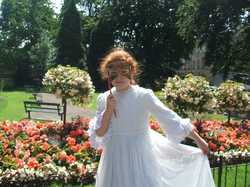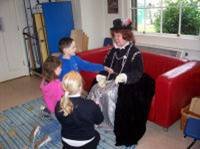History at Key Stage 1 and Key Stage 2
The main ways portraits can assist the curriculum is through:
- Knowledge, Skills and Understanding
- Historical Interpretation
- Historical Enquiry
- Assisting a link to an area in British / Local History
Key Stage 1
- Portraiture can assist knowledge, skills and understanding as portraits can be used to identify differences between ways of life at different times.
- Historical interpretation can be enabled by identifying different ways in which the past is represented within portraiture.
- Family portraits and portraits of children can be used to consider changes in their own lives and the way of life of their family or others around them.
- Portraits of famous people or significant men and women can be used to look at their lives and historical events or activities, such as the Gunpowder Plot or exploration.

Party People in History, summer school 2007. Portraits and the setting of the Sydney Gardens are used as sources for an exploration of the eighteenth-century pleasure garden, with mask- and hat-making among other activities.
© The Holburne Museum of Art
A good example: Imaging Children
The Holburne Museum of Art in Bath runs a workshop called ‘Imaging Children’ that looks at the differences between eighteenth-century and contemporary childhood and gets the children to think about families and their own lives.
This interactive workshop uses discussion prompted by questions and answers, drawing of portraits, dressing up in costume, trails around the museum and an in-depth art activity.
Key Stage 2
- Portraiture can be used as a basis to explore the characteristic features of the periods and societies studied, including the ideas, beliefs, attitudes and experiences of men, women and children in the past.
- Portraits can be used to illustrate how and why the past is represented and interpreted in different ways.
- Portraits can be used as source evidence for events, people and changes in the past.
- Portraiture of local people can be used as the basis for a local history study to explore how the area has changed over time.
- Portraits from these periods of British history can be used as the basis for a historical study: Britain and the wider world in Tudor times, Victorian Britain and Britain since 1930.

Tudor Splendour workshop 2007. Tudor portraits are used as sources for role-playing with Tudor artefacts and a discussion of Tudor life in Somerset. Children draw their own self-portrait miniature.
© The Holburne Museum of Art.
A good example: Tudor Splendour
The Holburne Museum of Art in Bath runs a workshop called ‘Tudor Splendour’, which looks at the life of a Tudor lady. It investigates the differences between a Tudor childhood and a contemporary one, through attention to homelife, religion, social life and structures.
The children are met by an educator in costume as Lady Elizabeth who tells them about her life and asks them about theirs. Two of the pupils are dressed up as children in Tudor times for the other children to draw. Trails and an art activity further cements the experience.
Holburne Museum ‘Tudor Splendour’ >>
